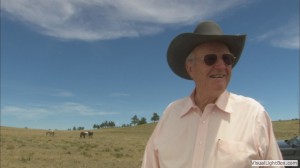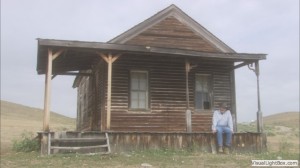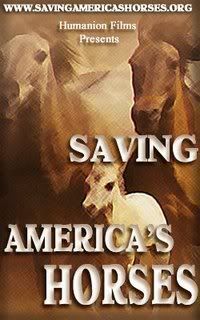“Wild horses are a great joy. Like my own freedom, I understood and cherished the spirit of freedom those animals have.”
 Dayton O. Hyde describes the 13,000 acres of land in South Dakota that is home to his Black Hills Wild Horse Sanctuary, along with the wild horses that live there, as “a national treasure.” Hyde himself, an 88-year-old cowboy conservationist, is as precious a national treasure, a hero fighting to the end to protect the land, the water and the wildlife of the American West.
Dayton O. Hyde describes the 13,000 acres of land in South Dakota that is home to his Black Hills Wild Horse Sanctuary, along with the wild horses that live there, as “a national treasure.” Hyde himself, an 88-year-old cowboy conservationist, is as precious a national treasure, a hero fighting to the end to protect the land, the water and the wildlife of the American West.
Hyde grew up in Michigan, where his family spent summers on a wilderness lake. “I spent a lot of time by myself when I was young,” Hyde says, his voice gravelly and thick, “and the wildlife became my friends. I determined that wild animals are afraid of people because of their energy fields. I got so that I could make myself into a pack of wet noodles, totally relaxed, and the wildlife was no longer afraid.”
Hyde’s solitary nature led him to write early on, and, in part to experience more adventures that he could write about, he left home at the age of 13 and hopped a freight train to Oregon, where he lived with his uncle on a cattle ranch. It was there that he learned to ride the wild stallions that roamed the area. Today, he says, “Writing is my favorite thing, outside of being on a horse.”
He served in World War II, then worked as a photographer and rodeo clown, before returning to Oregon, where he raised a family while stewarding the waterways and forests of his Yamsi Ranch. He is credited with saving the sandhill Crane from extinction, and has written many books about his efforts to protect the environment.
Like any hero, Hyde is flawed. At the age of 64, he left the ranch and his family behind to set out for new adventure, a move he now realizes caused his children a great deal of pain. “I felt, at age 64, I wasn’t doing anything with the talents I’d been given,” he explains. While riding cattle in Nevada, he came upon a corral of 2000 wild stallions that had been captured by the Bureau of Land Management. “They were a pretty sad bunch,” he says. “Wild horses are a great joy. Like my own freedom, I understood and cherished the spirit of freedom those animals have.”
 With just $14 in his pocket, Hyde headed to South Dakota, where he managed to convince others to “believe in my dream” to launch a nonprofit. With a BLM loan, he purchased a large plot of land near Mount Rushmore for wild horses to range. “I’ve travelled thousands of miles across this country and never found anything comparable to the beauty and isolation of the sanctuary land,” Hyde says. “It’s a startling beautiful place, full of canyons and Indian petroglyphs and sacred places.” He started with 300 mustangs; today, nearly 25 years later, the Sanctuary is home to 600 of them. “I try not to have favorites,” says Hyde, “but when I was putting these horses together years ago in Nevada a little blue yearling just came out of the herd and adopted me, followed me along the fence and just fell in love with me. She’s still alive, 27 years old now, still looks great. She comes up to me and nuzzles. That’s a better relationship than I’ve ever had with humans.”
With just $14 in his pocket, Hyde headed to South Dakota, where he managed to convince others to “believe in my dream” to launch a nonprofit. With a BLM loan, he purchased a large plot of land near Mount Rushmore for wild horses to range. “I’ve travelled thousands of miles across this country and never found anything comparable to the beauty and isolation of the sanctuary land,” Hyde says. “It’s a startling beautiful place, full of canyons and Indian petroglyphs and sacred places.” He started with 300 mustangs; today, nearly 25 years later, the Sanctuary is home to 600 of them. “I try not to have favorites,” says Hyde, “but when I was putting these horses together years ago in Nevada a little blue yearling just came out of the herd and adopted me, followed me along the fence and just fell in love with me. She’s still alive, 27 years old now, still looks great. She comes up to me and nuzzles. That’s a better relationship than I’ve ever had with humans.”
Hyde himself no longer rides. “I quit riding a few years ago because I realized that if I fell off and got hurt, it would be a triumph for the uranium people.” He is referring to a conglomerate that he is fighting in court that is trying to mine for uranium in South Dakota’s Black Hills by pumping millions of water along with uranium from the aquifer that feeds the Sanctuary’s horses. “Once they take the uranium out,” Hyde explains, “they’re going to pump water polluted with arsenic, heavy metals and selenium back into the aquifer. Once the water is polluted, there’s no other water. I can’t stand the thought of people doing that to the land—all in the name of money.
“I don’t know how we’ll win, but win we will,” Hyde continues. “You can’t quit. Those horses are there for their lives, and you become partners with them in preserving the land. As long as they live, you’re committed.”
In the meantime, he continues to manage the Sanctuary, repairing fences and feeding and watering his horses. “When I approach them,” Hyde says, “they smell me a half a mile long. They sniff the wind, and here they come.”
Hyde’s story—including his battle to stop the proposed uranium mining project—is the subject of “Running Wild,” an inspiring, beautifully shot documentary by the award-winner director, Suzanne Mitchell. It will premiere on Oct. 4 in theaters and Video On Demand.









No comments:
Post a Comment